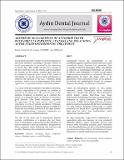Please use this identifier to cite or link to this item:
http://hdl.handle.net/11547/9665Full metadata record
| DC Field | Value | Language |
|---|---|---|
| dc.contributor.author | ÇAKAN, Engin Fırat | - |
| dc.date.accessioned | 2023-08-03T13:26:46Z | - |
| dc.date.available | 2023-08-03T13:26:46Z | - |
| dc.date.issued | 2016 | - |
| dc.identifier.uri | http://hdl.handle.net/11547/9665 | - |
| dc.description.abstract | In present time people consider more about appearance and facial aesthetics according to the past. Person in social communication is perceived by the expression on his/her face. The middle and the lower section of the face where the eyes, the maxilla and the mandible are located, are the primary attention spots and have an undisputed important place in social life. Smile of individuals, reveals the anterior teeth and disrupts or improves the harmony of the face. Therefore, dental aesthetics, which creates an important part of the facial appearance, is a prominent feature of overall aesthetic. As a result of the development of the adhesive dentistry, aesthetic expectations of the patients are possible to provide by the physicians. The main purpose of the aesthetic treatments in dentistry is to establish the design of a beautiful smile in addition to provide a good function. After dental procedures, especially the appearance of the upper anterior teeth is great importance in terms of patient satisfaction. Although, there are many types of treatment options available for functional and aesthetic problems in the upper anterior region, multidisciplinary treatment approaches are recommended for an optimal treatment. The aim of this study was to demonstrate anterior aesthetic rehabilitation of a patient who had Angle Class I malocclusion with crowding. Discoloration of anterior teeth due to previous treatments, managed with direct composite veneer following vital and non-vital in-office bleaching after orthodontic treatment | tr_TR |
| dc.publisher | ISTANBUL AYDIN UNIVERSITY INSTITUTE OF SOCIAL SCIENCES | tr_TR |
| dc.subject | anterior crowding, direct compositeveneers, laminate veneers | tr_TR |
| dc.subject | tooth bleaching | tr_TR |
| dc.title | AESTHETIC MANAGEMENT OF ANTERIOR TEETH WITH DIRECT COMPOSITE VENEERS AND BLEACHING AFTER FIXED ORTHODONTIC TREATMENT | tr_TR |
| dc.title.alternative | In present time people consider more about appearance and facial aesthetics according to the past. Person in social communication is perceived by the expression on his/her face. The middle and the lower section of the face where the eyes, the maxilla and the mandible are located, are the primary attention spots and have an undisputed important place in social life. Smile of individuals, reveals the anterior teeth and disrupts or improves the harmony of the face. Therefore, dental aesthetics, which creates an important part of the facial appearance, is a prominent feature of overall aesthetic. As a result of the development of the adhesive dentistry, aesthetic expectations of the patients are possible to provide by the physicians. The main purpose of the aesthetic treatments in dentistry is to establish the design of a beautiful smile in addition to provide a good function. After dental procedures, especially the appearance of the upper anterior teeth is great importance in terms of patient satisfaction. Although, there are many types of treatment options available for functional and aesthetic problems in the upper anterior region, multidisciplinary treatment approaches are recommended for an optimal treatment. The aim of this study was to demonstrate anterior aesthetic rehabilitation of a patient who had Angle Class I malocclusion with crowding. Discoloration of anterior teeth due to previous treatments, managed with direct composite veneer following vital and non-vital in-office bleaching after orthodontic treatment | tr_TR |
| dc.type | Article | tr_TR |
| Appears in Collections: | Untitled | |
Items in DSpace are protected by copyright, with all rights reserved, unless otherwise indicated.

